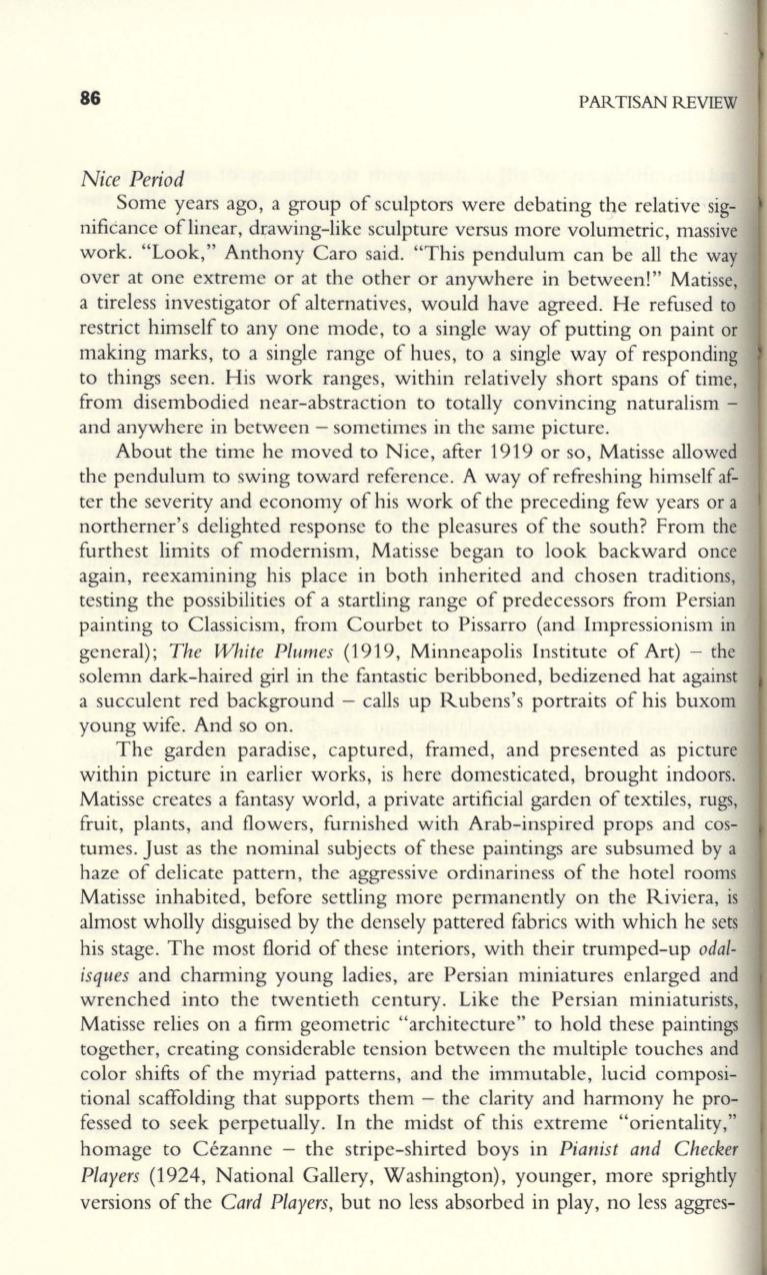
86
PARTISAN REVIEW
Nice Period
Some years ago, a group of sculptors were debating the relative sig–
nificance oflinear, drawing-like sculpture versus more volumetric, massive
work. "Look," Anthony Caro said. "This pendulum can be all the way
over at one extreme or at the other or anywhere in between!" Matisse,
a tireless investigator of alternatives, would have agreed. He refused to
restrict himself to anyone mode, to a single way of putting on paint or
making marks, to a single range of hues, to a single way of responding
to things seen. His work ranges, within relatively short spans of time,
from disembodied near-abstraction to totally convincing naturalism -
and anywhere in between - sometimes in the same picture.
About the time he moved to Nice, after 1919 or so, Matisse allowed
the pendulum to swing toward reference. A way of refreshing himself af–
ter the severity and economy of his work of the preceding few years or a
northerner's delighted response
to
the pleasures of the south? From the
furthest limits of modernism, Matisse began to look backward once
again, reexamining his place in both inherited and chosen traditions,
testing the possibilities of a startling range of predecessors from Persian
painting to Classicism, from Courbet to Pissarro (and Impressionism in
general);
The White Plumes
(1919, Minneapolis Institute of Art) - the
solemn dark-haired girl in the fantastic beribboned, bedizened hat against
a succulent red background - calls up Rubens's portraits of his buxom
young wife. And so on.
The garden paradise, captured, framed, and presented as picture
within picture in earlier works, is here domesticated, brought indoors.
Matisse creates a fantasy world, a private artificial garden of textiles, rugs,
fruit , plants, and flowers, furnished with Arab-inspired props and cos–
tumes. Just as the nominal subjects of these paintings are subsumed by a
haze of delicate pattern, the aggressive ordinariness of the hotel rooms
Matisse inhabited, before settling more permanently on the Riviera, is
almost wholly disguised by the densely pattered fabrics with which he sets
his stage. The most florid of these interiors, with their trumped-up
odal–
isques
and charming young ladies, are Persian miniatures enlarged and
wrenched into the twentieth century. Like the Persian miniaturists,
Matisse relies on a firm geometric "architecture" to hold these paintings
together, creating considerable tension between the multiple touches and
color shifts of the myriad patterns, and the immutable, lucid composi–
tional scaffolding that supports them - the clarity and harmony he pro–
fessed to seek perpetually. In the midst of this extreme "orientality,"
homage to Cezanne - the stripe-shirted boys in
Pianist and Checker
Players
(1924, National Gallery, Washington), younger, more sprightly
versions of the
Card Players,
but no less absorbed in play, no less aggres-


